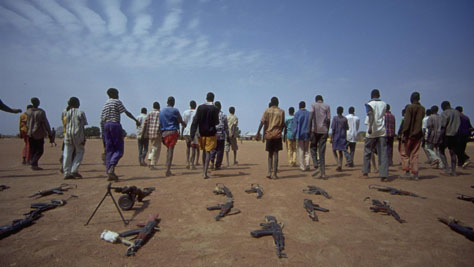Introduction
 © UNICEF/NYHQ2001-0093/Stevie Mann
© UNICEF/NYHQ2001-0093/Stevie Mann
The following provides an introduction to the Guidelines for the Monitoring and Reporting Mechanism (MRM) on grave violations against children and armed conflict under Security Council Resolutions 1612 (2005) [PDF], 1882 (2009) [PDF] and 1998 (2011) [PDF].
The publication of Graça Machel's seminal report in 1996 on the impact of armed conflict on children initiated a purposive agenda for the protection of war-affected children. A central priority and objective of this agenda has been to affirm the protection of children in situations of armed conflict as a fundamental peace and security concern.
The increasing role of the UN Security Council on this issue therefore represents a critical strategic imperative. The objective is to leverage the means of the Security Council, including its capacity to apply pressure through sanctions, to engender compliance with international standards for the protection of children.
Thus far, the Security Council has adopted eight resolutions on CAAC: 1261 (1999), 1314 (2000), 1379 (2001), 1460 (2002), 1539 (2004), 1612 (2005), 1882 (2009) and 1998 (2011). These resolutions serve as a framework for the Security-Council-related CAAC agenda, including the specific aspect of violations monitoring and reporting as covered by these Guidelines and accompanying Field Manual.
The Secretary-General has presented an annual report on the global situation of children affected by armed conflict to the UN General Assembly since 1998, and to the Security Council since 2000. The main purpose of the report has been to focus the attention of UN Member States on grave violations against children and on the parties who commit them. The Secretary-General's annual report serves as the substantive basis of the Security Council's engagement on CAAC.
In 2001, the Security Council mandated the Secretary-General to list, in an Annex to his annual report, state and non-state parties to conflict who recruit and use children in situations on the Council's agenda.1 Through subsequent resolutions the listing mandate has expanded to cover all situations of concern as determined by the Secretary-General, and to include parties who commit other categories of violations against children, specifically the killing or maiming of children, and rape or other forms of sexual violence.
In order to systematize and strengthen the practice of reporting, in 2004 the Security Council requested the Secretary-General to prepare an Action Plan for the Establishment of a Monitoring, Reporting and Compliance Mechanism.2 Following extensive consultation among UN agencies, non-governmental organizations (NGOs) and UN Member States, the Secretary-General presented this Action Plan in his report (S/2005/72) [PDF]. The Council endorsed the Secretary-General's proposal in Resolution 1612 (2005), leading to the formal establishment of the MRM on Grave Violations against Children.3
These Guidelines describe the purpose and focus of the MRM; specify the leadership, roles and responsibilities of implementing actors; describe the MRM architecture and information flow; outline reporting requirements; and highlight the critical linkage of the MRM to response programming and advocacy.
1 Requested by Security Council Resolution 1379 (2002), (OP 16).
2 Requested by Security Council Resolution 1539 (2004), (OP 2).
3 Reference Security Council Resolution 1612 [PDF], (OP 2).